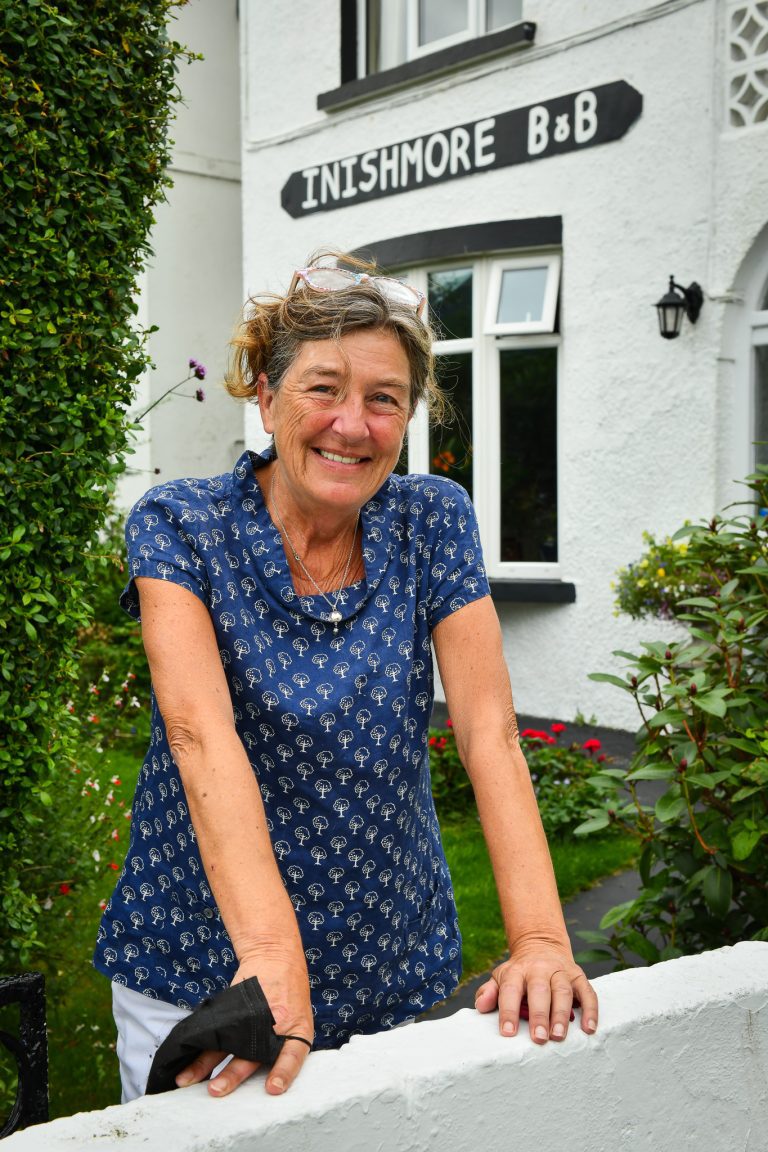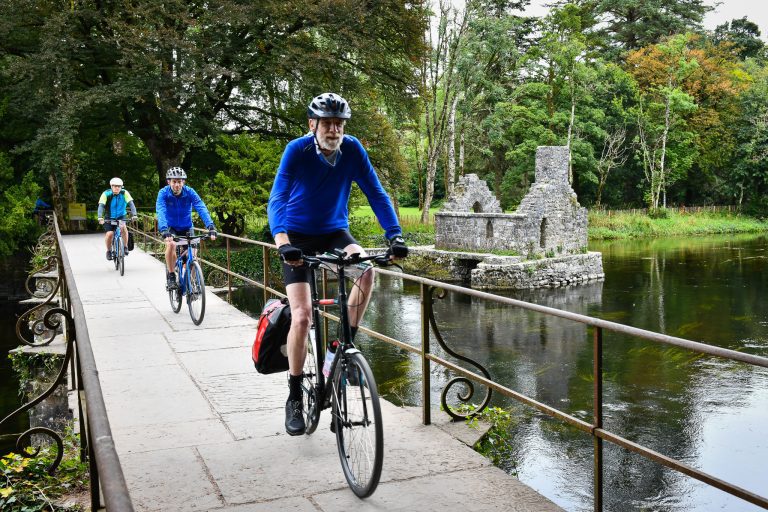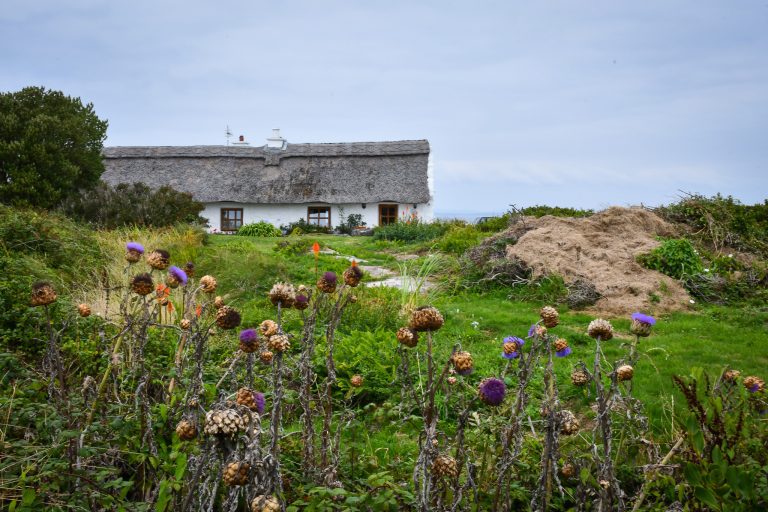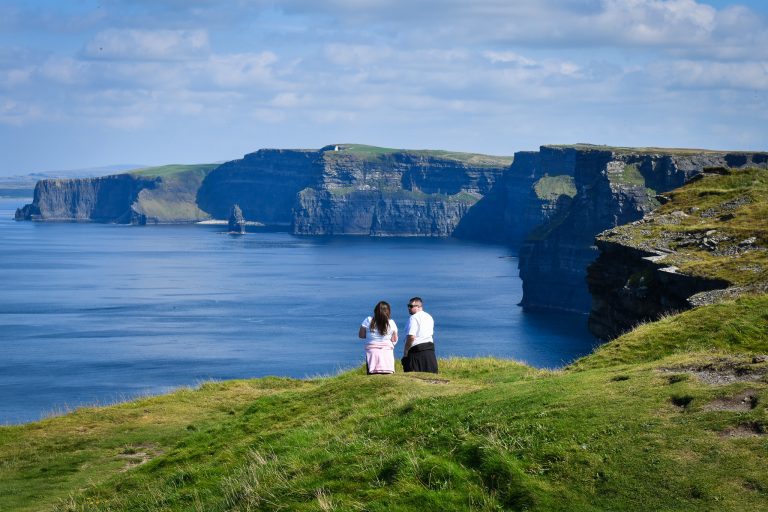(Cont.)
The Irish are survivors. They’ve had to survive slavers, Vikings, Norman conquest, Cromwell, oppressive British and landowner control, famine, a relentlessly wet climate, an unforgiving landscape and successive economic downturns. And yet, they are an ebullient people with uplifting music and dance, a welcoming attitude, happy traditions and a kind spirit. The tragedies they’ve experienced are etched on the land at nearly every turn.
On the grassy hillsides surrounding Leenaun, look closely and you see parallel horizontal lines scribed in the turf, remnants from the Great Famine when the Irish, desperate for a way to grow potatoes, terraced rows of potatoes up the mountainsides in the mistaken belief that better soil up the mountain would grow them. What they didn’t know in the late 1840s was that the potatoes were experiencing a blight, a disease that was destroying the leaves, roots and tubers of the plant. No amount of terracing would change that.
That sad episode is noted at a monument identifying the Doolough Tragedy of 1849 in which starving families, dependent upon relief, were told to meet British agents in Westport to verify that they should continue to receive assistance. Instead, the agents traveled to Delphi Lodge, 12 miles south, and instructed the poor to meet them there. Hundreds of famished men, women and children trudged across Doolough Pass overnight wearing little more than rags through very bad weather, and when they arrived were told there was nothing to eat. The officials eventually dismissed them after first having their own breakfast.
Many had died along the way. Their frail bodies littered the pass they’d labored to cross or were blown into Fin Lough by strong winds. Corpses were found with grass in their mouths from one last, futile attempt at nourishment. This ride is one of the add-ons and well worth the effort. Though pedaling the route is a far cry from what these people endured, it more intimately connects you to what happened than most anything else. The route travels beside one of three glacial fjords in Ireland, a ribbon of twisting blue that passes between lovely hills that were once stained with tears. In Irish, Doolough means “black lake.” Upon the monument an inscription from Mahatma Ghandi reads, “How can men feel themselves honoured by the humiliation of their fellow beings?”
From Leenaun on, the ride is uplifting. You follow the Connemara Loop past Kylemore Abbey (a gingerbready, much-photographed, Victorian castle that now is home to a community of Benedictine nuns) and through Connemara National Park with breathtaking views of the Twelve Bens (impressive peaks), before descending into the seaside town of Clifden.
Grant, a cyclist from Arkansas, said he was prepared for Ireland’s greenery, but was surprised by the size of what the Irish call their “hills” which look more like mountains. Gaelic has many names for hill: beinn (ben), cárn, sgùrr, meall, druim, aonach and numerous others, yet the Irish call even the tallest of their mountains, hills. In the U.S., the difference between hills and mountains was officially 1,000 feet, until the distinction was abandoned in the 1970s. Today, apparently, even an American molehill can be called a mountain, though in Ireland, everything’s a hill.
“Picturesque” is an overused word, but not in Clifden’s case. It has a charming fishing harbor vibe with town buildings colored pink, orange, blue, white, red and mint green, as a Clifden local explained, “to brighten dreary days.” The town square honors aviation pioneers Alcock and Brown who, in 1919, landed nearby, successfully completing the first non-stop transatlantic flight. Shops, restaurants, and pubs cater to visitors, but aren’t “touristy.” Shops sell Aran sweaters, but mostly the stores attract locals with goods a visitor would also appreciate. Sean Price, the butcher at Moran’s Meats knows that tourism drives the town’s economy and is eager to explain how they make their white and black pudding (a sausage that’s part of a full Irish breakfast). E. J. Kings is one of Ireland’s Joyce Pubs. The clientele is decidedly local, cheering Irish football in European play as their pints warm and their fish and chips cool or enjoying a delicious Irish lamb stew of broth, carrots, celery, herbs, ribbons of lamb and golden potato mash topped with an edible Nasturtium.
Although you can choose to dine wherever you want while on a cycling tour, it’s common for those who share the ride to also dine together. That means, fine dining is not a usual choice and pubs are. Fortunately, Irish pubs employ good cooks. Common choices are seasoned burgers, fish and chips (often with fresh cod and tartar sauce [never vinegar – that’s English] and in a beer batter that’s not oily), an Irish stew or savory beef and Guinness pie, steamed or pan-fried salmon, some sort of curry dish (usually chicken), salads, a generous serving of Killary mussels and, of course, accompanied by a pint of creamy Guinness, French wine or cider and always a basket of Irish brown or soda bread with Irish butter. Everything comes with potatoes: fried, boiled, or mashed. Skip dessert unless you have room to take in an additional large portion of ice cream, cake, or pudding. It’s a pub, so they’re used to splitting checks and the price includes service fees.
From Clifden, the tour cycles south across the Old Bog Road, a one-and-a-half-lane strip that passes through lush heather, rock outcroppings and has distant views of the Twelve Bens and Maumturk Mountains.
To Beth and Lindsay, cyclists from Boston, the trip was a way for Beth to celebrate her 40th birthday. She came, ” Just to have fun and drink some Guinness,” though said, “Anyone who has the chance to do this, should do so. It’s stunning scenery.”
Along the Bog Road, the perfection of the verdant heather, embellished with pink, lavender and yellow flowers that wrap around ancient rock formations, seems landscaped. Legend says that it’s good luck to find white flowers amidst the heather. Cyclists have time to search for white flowers while riding along the road and they’ll need the luck those blossoms convey should they encounter any of the ghosts of Neolithic and bronze age farmers said to haunt the bog.
Blanket bogs (so named because they lie like blankets upon the land) act like rainforests; they absorb water and release it slowly through the year, feeding streams of spawning salmon and trout. Bogs have, for centuries, been a primary source of heating fuel for Irish homes. Even today, stacks of “turf” are cached along the bog road, waiting to be used to heat Irish homes. Their pungent smell (called “peat reek”) permeates the roadside air, reminding one of a jigger of Jameson, Ireland’s best-selling whiskey, which dries its malt over a peat-heated fire, conveying a smoky flavor to the barley grain and giving the whiskey its distinctive taste.
At Carna, the end of the day’s ride, there’s more to explore. The enthusiastic shouts of a Gaelic football team practicing on the town sports ground distracts you as you pedal toward Mweenish Beach and past a farmhouse with its harvest of massive onions waiting to be transformed into a local delicacy, white onion and sage soup. At land’s end is one of many abandoned stone cottages. What would be priceless ocean-front property elsewhere, is just another scenic seaside relic in Ireland.
On Day five, cyclists ferry their bikes over to Inis Mór, the largest and westernmost of Ireland’s Aran Islands, but with only 840 residents. This is a day spent exploring with little riding. More forgotten cottages and rock walls lattice the island. Local tour driver, Noel Moher, a “blow in” who married a local girl, says they were owned by bachelors whose American cousins likely inherited them and have no plan to renovate the 200-year-old ruins.
Connemara pony carts and tour buses climb to the island’s main attraction, the pre-historic Dún Aonghasa, a massive fortress that backs up to sheer, 330-foot cliffs above the Atlantic Ocean. Irish archeologist George Petrie called it “the most magnificent barbaric monument in Europe.” It’s so old (1,100 B.C.) that there’s no record of who it defended the Irish from, though a cheveaux-de-frise (defensive barrier) of jagged, upright stones, beyond its third wall, leaves no doubt that it was a fortress.
Thomas Cahill writes in “How the Irish Saved Civilization,” that few realize that were it not for Irish monks during the dark ages, all previous learning would have been lost. Just as mainland Europe was experiencing economic, intellectual and cultural decline, which stemmed from the fall of the Roman Empire, Ireland had just ended a long period of economic and intellectual stagnation. The abbey on Inis Mór became one of Europe’s remaining learning centers, rescuing libraries, sciences and histories that otherwise were being discarded across the continent. Scholars came from afar to study. At the Abbey of the Seven Churches on Inis Mór (it had only two churches, the rest were monks’ quarters), the 9th-century graves of seven Romans (who had traveled to this remote island from Imperial Rome to study) testify to the fame of Aran’s schools.
Today, the Aran Islands’ greatest claim to fame is its sweater. The Aran Jumper is an off-white, cable-knit cardigan made famous by local fishermen who found that the lanolin from Connemara wool would shed water and keep them warm, even when the sweater was soaked. Shops sell many styles of Aran sweaters throughout west Ireland (they’ve become sort of an Irish fashion statement), and it’s hard to resist purchasing one when you’re visiting the Aran Islands.
Rain is a given in Ireland. Nearly every weather report includes “a chance of rain,” though Irish rain, during cycling season, is rarely a downpour. More often, it’s a half-hour drizzle. Nevertheless, it’s wise to carry a rain jacket and pants made for cycling. They keep you dry, breathe and offer flexibility. As for clothing, two sets of cycling jerseys and two sets of cycling shorts, a high-visibility light cycling jacket, and two shirts and pairs of pants, a sweater and or fleece to wear at day’s end are all you need to pack. Two pair of athletic shoes (one to wear riding), woolen socks and under garments and a toilet kit complete what most riders brought with them. A few left with Aran sweaters.
On the ferry ride back to mainland Ireland, you see the objective of the following day’s ride, the imposing Cliffs of Moher.
A B&B in Doolin is your home for the next two nights. Doolin is the quintessential Irish village with its main road bending to the contours of the village creek which is crossed at several points by stone bridges. The shops, restaurants, inns and its four pubs are brightly painted pink, yellow, white and lime green, again to ward off winter blues. Doolin is best known as a center of traditional Irish music.
On a typical evening (traditional music is performed nightly), townsfolk and visitors gather about McGadden’s Pub as pub sessions composed of quartets of fiddlers, banjo players, guitarists, flutists, accordionists, pipers or singers perform lively Irish Trad. Sometimes, the house band, paid to perform nightly, is supplemented by patrons, usually a singer. On one night a lass broke away from her girlfriends to sing Ed Sheeran’s The Parting Glass with the band.
On another, it was a white-haired local farmer wearing a tweed flat cap and chin beard with braided goatee who sang a Sean-nós, emotionally,
“… And we’ll all go together
To pluck wild mountain thyme
All around the blooming heather
Will ye go lassie, go?”
Then, Ronan O’Connell, a 22-year-old tenor from nearby Ennistymon, who performs regularly at McGaddens, sang a Caoineadh (Irish lament) expressing his sorrow over the loss of a fair woman,
“… So softly fills my room,
with her haunting sweet perfume,
here then gone forever,
my bonnie Belfast rose,”
Then, the multi-generational audience of greying men and women, young parents and their children, lads out for a pint, lassies holding a celebratory bridal shower and cyclists visiting Doolin for the first time joined the tenor to sing the ending refrain,
“… Farewell my restless visions,
gone like glad old clothes,
some you keep forever,
but not my Belfast rose.”
Irish pub sessions bring the generations together. Like the pubs of Ireland, they are genuine, friendly and performed in the presence of good company.
Cycling up out of Doolin towards the Cliffs of Moher to the south, there is a sense something great lies ahead. The Cliffs of Moher are a remarkable natural attraction. Situated at the southwest end of The Burren (Place of Stone) region of County Clare, they are sheer, 70-story-tall sea cliffs that extend 9 miles.
A visually stunning visitor center built into a hillside, so that it has minimal environmental impact on the site, contains a world-class, walk-through museum with interactive and multi-media exhibits and theaters that bring to life the history, geology, flora and fauna of the cliffs.
A UNESCO Global Geopark, Cliffs of Moher was a “tourist attraction” long before the term was coined. Cornelius O’Brien, a wealthy Irish politician, built O’Brien’s Tower as an observation tower in 1835 for the hundreds of tourists that visited the cliffs and to entertain friends in what a guide called “the world’s first man cave.”
A million visitors walk the cliffs each year, making it Ireland’s favorite visitor attraction. Some venture close to its precipitous edge to look hundreds of feet down upon the sea. It is an experience not for the faint-hearted. At the cliffs’ southern terminus is Moher Tower built during the Napoleonic era to warn of the approach of the French fleet.
Riding south from the cliffs, the tour reaches its southern-most point in the town of Lahinch, celebrated for its golf course. The Lahinch clubhouse bar is considered by golfers to be one of the best in Ireland, as is Lahinch’s Cornerstone Pub. Pubs are important to golfers who prize good times and good humor as much as they do low scores.
Standing with bike along a sidewalk beside the 18th hole at Lahinch GC, a cyclist was hailed humorously by a golfer who’d just driven his approach shot to just feet from the cyclist, “Good thing you’re wearing a helmet!” The cyclist tapped his helmet and replied, “Good thing you’re not worse at this game.” Inside the men’s room at the Clare Coast Hotel, a sign reads, “The Lahinch Golf Club give Notice that all trespassing donkeys and other animals, must be removed from the Links forthwith. Owners of trespassing donkeys are furthermore hereby warned that any donkey or donkeys found on the Links on or after November 26th, 1927 will be driven from the lands and impounded.”
That rule might still apply. As, wherever you ride throughout The Burren, small red, white and blue signs announce “donkey farm tours.” Donkeys and ponies have a traditional connection to Ireland. When horses were scarce, donkeys replaced them for farm work. Today, donkeys and Connemara ponies are kept as pets. Inis Mòr pony cart driver Tony Haferty said, “every house on the island has a pony.”
While in Lahinch, the town resounded with blaring car horns as the winning Gaelic football girls’ team from rival Liscannor, across the bay, celebrated their victory against Lahinch’s team by driving through town with fists raised. The people of Lahinch exhibited restrained sportsmanship by applauding the Liscannor girls and good naturedly accepting their team’s loss. Intimate scenes like that say a lot about a place and can only be experienced when you have the immediacy of moment, allowed on a bike.
The return from Lahinch routed the cyclists down a brake-burning descent and past Doonagore castle before arriving in Doolin for another night of Irish music and dining. Standing outside McGadden’s Bar, locals quickly knew the cyclists were tourists. “The Americans are back,” one said under his breath, so as not to offend. Another approached a cyclist and posed an oft-asked question … “Do you have blood?” Meaning, “Are you of Irish descent?”
The Irish share a kinship with America and missed seeing Americans during the pandemic. More than 31.5 million Americans claim Irish descent. That’s more than six times more Irish-Americans than the population of Ireland. Soon, everyone at McGadden’s – the Irish and visitors alike – were tapping their toes, sipping their pints and smiling as the musicians played on.
The following morning, a 30 km pedal north to Ballyvaughn brought the tour into the heart of The Burren, a barren, glacier-scoured, limestone moonscape that touches the Atlantic. Deep cracks cross the grey stone shelves were etched away over centuries as calcite veins were washed away by rainwater.
Up the coast at Fanore Beach, locals were enjoying a dry Sunday on its lightly tread, gold and grey sands. An Irish family said visiting the beach became a popular way to escape the confinement of being inside during the pandemic. For them, a day at the beach is now common in all seasons and weather. It’s replaced going to the cinema.
In the beach’s parking lot, a large number of locals who support the Royal Navy Lifeboat Institution had gathered for an 8 km charity walk. Joe Quelly, the walk’s organizer, described the Irish as “a great and generous people” who turned out enthusiastically to raise funds for the rescuers who’d saved 349 people from drowning this past year along the Irish coast. It was tempting to join the walk, talk to the locals and support their cause, but there were miles more to pedal to Ballyvaughn.
On arrival, there was still time in the day to explore the barren Burren, rest or eat a snack at the ice cream shop. The cycling tour would end the next day and so several in the group chose to ride up to the 10th century Caherconnell Cashel ringfort, as it would be closed the following morning when the group rode past. The cyclists also decided to hold their final dinner that night at a local restaurant, as all would be heading in different directions once they returned to Galway.
Poulabrone Dolmen, near the ringfort, is a 5,000-year-old burial ground that served as a location for ceremonies and rituals into the bronze age. Resembling a mini-Stonehenge, the Dolmen’s archeological digs discovered artifacts among the ancients buried there. At its entrance, hammering away on a Celtic object was master craftsman Tomás Ó Cadháin. He is among many artisans and buskers granted permits to craft objects or perform near public historic landmarks and, with little prompting, Tomás will read a poem he wrote in memory of his sainted grandmother, confirming the notion that all Irish are poets and romantics.
Beyond the Dolmen is the privately managed Caherconnell Cashel, a medieval-era stone ringfort that protected local inhabitants from Viking raids as early as the 10th century on a site known to be inhabited as early as the 7th century B.C.
Colin Davoren stood inside its visitor center answering questions and admitting people. He is a descendant of Davorens who have owned and farmed this land for centuries. Their name literally means, “of The Burren.” He said of Caherconnell, “It has, as a family, kept us here. There’s a magnetism, almost a cultural magnetism, that keeps us coming back. I remember as a small boy the fort was my playground. We’d play tag around the fort.”
Recognizing that the site was slowly being lost, starting in 2005 Colin’s father, John, retained archeologists to survey, excavate and restore the site, discovering rare artifacts and jewelry in the process. They put together a digital survey of the fort and a record of its rich history, which is interpreted through professional displays, self-guided tour, a multi-media theater, a guidebook and interpretive signs every bit as good as those found in American national parks. Sheepdog demonstrations show some of the site’s long-standing agricultural practices.
It’s believed an agricultural settlement at Caherconnell was established in the late 10th century by a member of the local royal family (Congal/Connell) and that occupation continued to the 17th century. The Caherconnel ring, a delicate medieval silver ring inscribed with a Celtic symbol, was found during excavation and five wives within the Davoren family each received the first of its replicas. Additional replicas are sold in the visitor center’s store and contribute to the maintenance of the site and its presentation to the public.
From the 13th to 16th centuries, Carran church, a short distance beyond the ringfort, was the primary church of the largest parish in The Burren. The church was self-fortified to defend against local attacks and has the three-dimensional face of an Irish knight wearing a helmet on an interior wall. Inside the church is the ancient Celtic cross of the Davoren family plot, indicating the family’s local prominence through the ages.
In Carran, another family owns Burren Perfumery which makes perfumes and cosmetics inspired by the Irish landscape. In the Blending Room, visitors can watch workers Rose and Cate make organic balms and creams or view audio-visual presentations about soap making and the flora and fauna of The Burren. There’s a garden to tour and a small cafe where local women serve homemade soup and freshly baked breads, local cheeses, tea, coffee and cakes. But mostly, there’s a sense that you’re at an authentic place where the people of The Burren, not corporate salons or marketing experts, have put themselves and The Burren into their exceptional products. Several of the cyclists waited until reaching the perfumery to buy gifts, as travel-friendly soaps and perfumes made a classy Irish keepsake brought home.
The final pedal from Carran to Kinvara is a long, downhill stretch along an empty, one-lane road banked by hedges of Irish hazel. It provided time to reflect on the joys and experiences of the preceding week. It’s an exhilarating and personal finish to eight days of touring West Ireland.
During those eight days on the road, cyclists from Maryland to Alaska bonded and shared the intimate experience of touring West Ireland and meeting its people, history and culture that only doing so on a bicycle can provide.
More about West Ireland Cycling is found at westirelandcycling.com.





